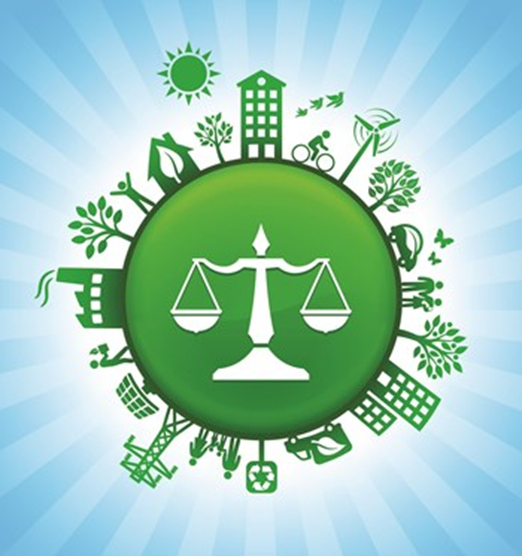A LAW AROUND LOW-CARBON CLIMATE RESILIENT DEVELOPMENT
Relevance: GS 3 – Conservation, environmental pollution and degradation, environmental impact assessment.
Why in the News?
- The Supreme Court of India recently recognized a right to be “free from the adverse impacts of climate change” in the K. Ranjitsinh and Others vs Union of India case.
- This right is derived from the right to life and the right to equality.
- The judgment is seen as a significant step in establishing climate jurisprudence in India.
- The decision raises important questions about how this newly recognized right will be protected.
Current Need in Climate Crisis
- Patchwork of Judicial Interventions: A patchwork of judicial interventions is insufficient for the comprehensive and systemic approach needed to address climate change.
- Need for Climate Legislation: There is a strong case for enacting climate legislation, provided it is specifically tailored to the Indian context.
- Opportunity for the New Government: This issue presents both an opportunity and a challenge for the new government to take decisive action.
Need of Climate Law for informed Development Choices
- Re-orienting Development Choices
- Low-Carbon and Climate Resilient Futures: Development must shift towards low-carbon and climate resilient pathways.
- Objectives of low-carbon development and climate resilience should be internalized in everyday decision-making across all development levels.
- Social Justice Imperative: Climate change impacts the vulnerable the most; thus, an energy transition must advance social justice.
- Move Beyond Emission Limits: Climate law in a developing country context goes beyond setting emission targets.
- Requires ongoing consideration of each developmental decision and its long-term impacts on low-carbon and climate resilience.
- Procedural Implementation: Protection against climate change impacts must be enforced through well-defined legal procedures at all government levels.
- Institutional Structure: Effective climate action needs a well-designed institutional structure for strategizing, prioritizing, troubleshooting, and evaluating policies.
India and Global Governance on Climate action
- 67 countries have implemented framework climate laws to build governance capacity for climate action.
- These laws define government-wide goals with processes and accountability measures.
- Tailoring to Indian Context
- Low Per Capita Emissions: India starts from a low base of per capita emissions, less than half the global average, with growing emissions.
- Maximizing Development per Carbon Ton: Focus on extracting maximum development benefits from each ton of carbon while avoiding high-carbon futures.
- Climate Vulnerability: High vulnerability to climate impacts makes climate resilience essential in new laws.
- Social Equity Considerations: Social equity must be central in balancing development and climate objectives.
- Navigating Developmental Choices
- Thoughtful Decision-Making: Law should enable thoughtful choices towards a low-carbon, resilient society.
- Urban Planning: Cities are rapidly growing; need to envision low-carbon, climate-resilient cities.
- Minimizing Risks: Plan to reduce flood risks and vulnerability to heatwaves in city development.
- Transport Needs: Shift towards electric vehicles, improved public transport, and lifestyle changes to meet transport needs sustainably.
Establishing a Low Carbon Development Body
- Institutional Framework
- Framework Climate Law: Should establish an institutional structure capable of addressing key developmental questions.
- Knowledge Body: Propose an independent ‘Low-Carbon Development Commission’ staffed with experts to advise national and State governments on achieving low-carbon growth and resilience.
- Deliberative Decision-Making
- Inclusive Consultations: Systematically consult vulnerable communities and stakeholders affected by technological changes for sustainable policy outcomes. Example from South Africa: Learn from the Presidential Climate Commission’s approach to ensure a just transition through stakeholder inputs.
- Strategic Governance
- Climate Cabinet: Propose a ‘Climate Cabinet’ comprising key Ministers and Chief Ministers from States to drive strategic climate policy across government levels.
- Breaking Silos: Address siloed decision-making by integrating climate considerations into line ministries’ strategies.
- Coordination Mechanisms
- Whole-of-Government Approach: Establish dedicated coordination mechanisms for climate policy implementation.
- Role of Ministry of Environment: Enhance the Executive Committee on Climate Change’s role with specified legal powers and duties for effective coordination.
Engaging with India’s Federal Structure
- Importance of Federalism
- Decentralized Governance: Many critical sectors like electricity, agriculture, water, health, and soil fall under State and local government jurisdictions.
- Local Impact of Climate: Climate impacts are most acutely felt at the local level, necessitating local engagement.
- Institutional Integration
- Access to National Scientific Capacity: Law should facilitate subnational governments’ access to national scientific expertise, potentially through intermediaries like the Low-Carbon Development Commission.
- Financial Support for Local Action: Introduce mechanisms to finance local climate actions, such as aligning centrally-sponsored schemes with climate goals and tagging national expenditures for local climate resilience.
- Coordination Mechanisms
- Consultative Decision-Making: Establish coordination mechanisms for Centre-State consultation on major climate decisions.
- Medium-Term Climate Plans: Mandate periodic updates of medium-term climate plans aligned with unified national goals.
- Complementary Legal Framework
- Framework Law Role: The proposed framework law should catalyze action across national ministries and federal structures but should complement existing sectoral laws and amendments.
- Sectoral Specificity: Sectoral laws should align with the overarching framework law’s principles and approach.
- Realizing the Promise
- Legal and Governance Changes: Leveraging the M.K. Ranjitsinh judgment to enact a climate law tailored to India’s needs.
- Steering Development Choices: Directing Indian development towards a low-carbon, climate-resilient future while promoting justice.
Associate articles
https://universalinstitutions.com/court-on-climate-right/
https://universalinstitutions.com/sc-declares-right-against-climate-change-a-fundamental-right/
Mains question
Discuss the significance of India’s federal structure in crafting effective climate legislation post-M.K. Ranjitsinh judgment. How can legal frameworks integrate subnational governance for sustainable development? (150 words)





